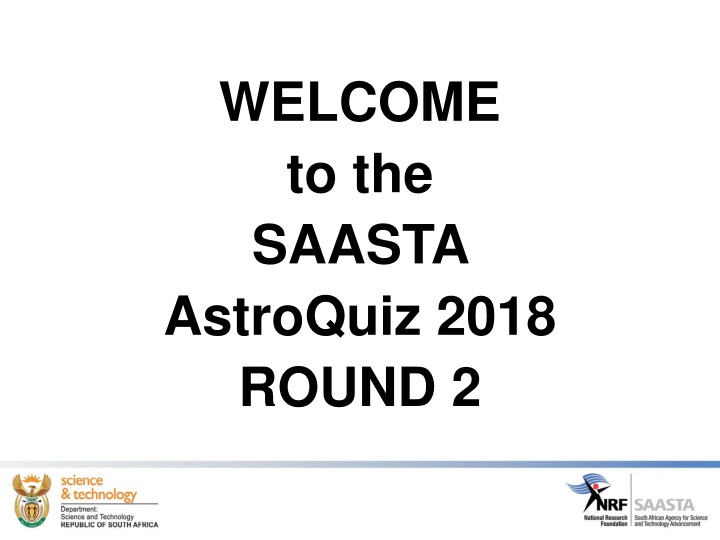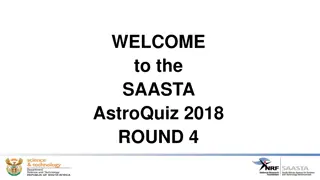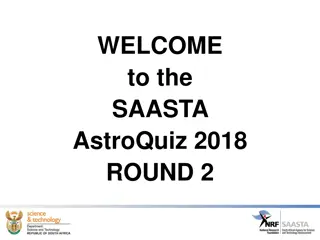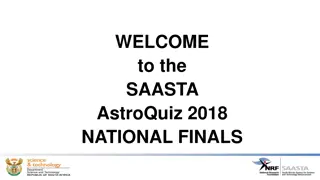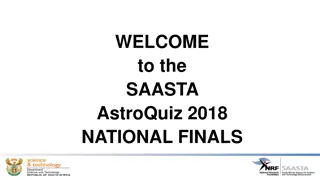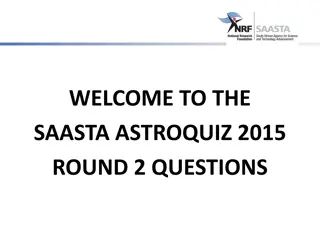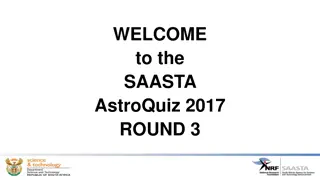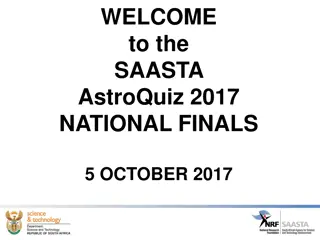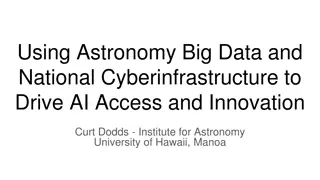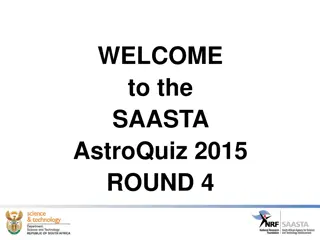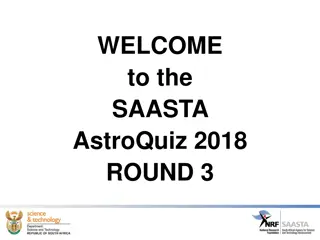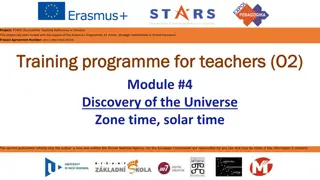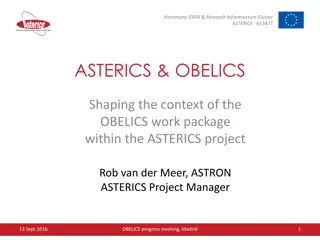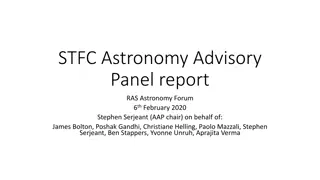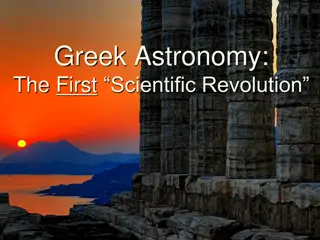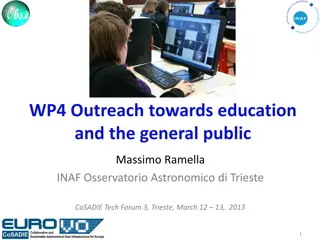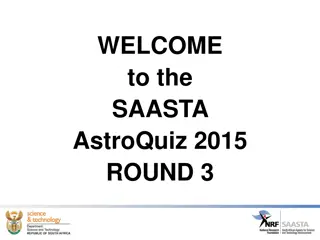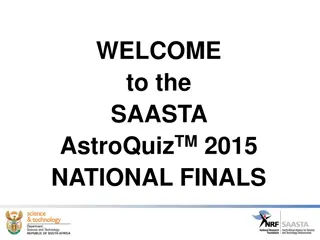SAASTA AstroQuiz 2018 Round 2 - Test Your Astronomy Knowledge!
Welcome to the SAASTA AstroQuiz 2018 Round 2! Join the quiz where you have 60 seconds to answer 8 challenging astronomy questions. Test your knowledge on topics like the Sun, stars, galaxies, and more. Can you answer questions about the speed of light, the fate of our Sun, and celestial bodies in our solar system? Engage in this fun and educational astro challenge with your team!
Download Presentation

Please find below an Image/Link to download the presentation.
The content on the website is provided AS IS for your information and personal use only. It may not be sold, licensed, or shared on other websites without obtaining consent from the author.If you encounter any issues during the download, it is possible that the publisher has removed the file from their server.
You are allowed to download the files provided on this website for personal or commercial use, subject to the condition that they are used lawfully. All files are the property of their respective owners.
The content on the website is provided AS IS for your information and personal use only. It may not be sold, licensed, or shared on other websites without obtaining consent from the author.
E N D
Presentation Transcript
WELCOME to the SAASTA AstroQuiz 2018 ROUND 2
RULES You only have 60 seconds to answer all the questions. You are allowed to discuss amongst yourselves as a team. Calculators may be used if needed. No internet is to be used, therefore the use of cellphones is prohibited. The judge s decision is final.
QUESTION 1 How long does it take light from the Sun to reach the Earth? A. 24 hours B. 8 hours C. 8 seconds D. 8 minutes
QUESTION 2 Which of the following arrangement represent a star, constellation respectively. galaxy and A. Rigel, Cluster, Scorpio B. Scorpio, Neptune, Rigel C. Sun, Milky Way, Sirius D. Sirius, Andromeda, Orion
QUESTION 3 At the end of its life as a star, our Sun will become a ______ A.Supernova B. Black hole C. Black dwarf D.Neutron star
QUESTION 4 To which galaxy does our Sun belong? A. Andromeda Nebula B. Large Magellanic Clouds C. Small Magellanic Clouds D. Milky Way Galaxy
QUESTION 5 Which of the following statements about the Sun, is true? A. It is the biggest and brightest star in the Universe B. It is hot, rotates and always changes C.It always goes around the Earth D.It is bigger than the Earth but smaller than the Moon
QUESTION 6 The Sun also plays a role of a big anchor which creates gravity that keeps planets in their orbits. A. True B. False
QUESTION 7 There are some solid particles that can be found in the Sun. A. True B. False
QUESTION 8 We always see the same side of the Moon from Earth because ____ A. The rotation rate on its axis is the same as its orbital period around the Earth The Moon goes around the Earth that also goes around the Sun The Moon is the Earth s only natural satellite The Moon is not rotating at all B. C. D.
QUESTION 9 Scientists observe changes on the Sun by watching sunspots which are caused by ______ A. Rotation of the Sun B. Rotation of the Earth C. Strong magnetic fields D. Strong electric fields
QUESTION 10 The Moon is the only place in our solar system, other than Earth, where human beings have been. A.True B. False
QUESTION 11 On 20 July 1969, Neil Armstrong became the first to set foot on the Moon and the final human lunar landing was in ___ A. 1969 B. 1972 C. 1980 D. 2015
QUESTION 12 The space capsule that took Mark Shuttleworth to the International Space Station was the _____ A. Mir B. Salyut C. Soyuz D. Vostok
QUESTION 13 At what average speed does the Earth go around the Sun? A. 39,8 m/s B. 39,8 km/s C. 29,8 km/s D. 29,8 m/s
QUESTION 14 At what average speed does the Moon go around the Earth? A. 9,80 km/h B. 9,80 m/h C. 3,68 m/h D. 3,68 km/h
QUESTION 15 The Moon has no light of its own but shines by reflecting sunlight from its surface. A. True B. False
QUESTION 16 Mark Shuttleworth once toured space for a week. Where exactly in space did he go to? A. Salyut B. Russian Soyuz C. International Space Station D. The Moon
QUESTION 17 Colours of stars can tell their surface temperatures. Which of the following arrangement represents colours of stars from hottest to coolest. A. B. C. D. Blue; white; yellow; orange; red White; yellow; orange; red; blue Red; orange; yellow; white; blue Orange; yellow; blue; white; red
QUESTION 18 What is the name of the third closest star to the Earth? A. Proxima Centauri B. Alpha Centauri C. The Sun D. Centaures
QUESTION 19 Which instrument is amongst those used in studying the Sun s eruptions? A. Monet B. Square Kilometer Array C. Southern African Large Telescope D. Solar and Heliospheric Observatory
QUESTION 20 The coolest part of the Sun which produces the light we can see with our eyes is referred to as the __ A. B. C. D. Exosphere Corona Chromosphere Photosphere
QUESTION 21 Magnitudes give us information about ________ of celestial bodies. A. Size B. Brightness C. Shape D. Mass
QUESTION 22 The primary/main mirror of the Southern African Large Telescope, SALT, is comprised of ____ individual mirrors. A. 90 B. 91 C. 120 D. 102
QUESTION 23 The shape of the mirrors in the Southern African Large Telescope, SALT, is ____ A. Heptagonal B. Hexagonal C. Pentagonal D. Octagonal
QUESTION 24 During sky viewing, how can one differentiate a planet from a star without using a telescope? A. A star will be brighter and bigger than a planet B. A planet will be brighter and bigger than a star C. A star will appear to twinkle whilst a planet will not D. A star will have colour whilst a planet will not have colour
QUESTION 25 Stars appear to twinkle because ___ A. There is a great amount of light from the Sun that passes through the Earth s atmosphere that is shining on them B. The light from the star gets refracted or bent, as it passes through the different layers of the Earth s atmosphere C. There is a lot of gaseous reactions taking place inside and this causes a star to appear to twinkle at night D. There is too much sunlight in the sky
QUESTION 26 Stars are closer to the Earth than planets. A. True B. False
QUESTION 27 Which of the following is the correct sequence of Moon phases? A. New moon, first quarter, full moon, third quarter First quarter, new moon, full moon, third quarter First quarter, full moon, new moon, third quarter Full moon, first quarter, new moon, third quarter B. C. D.
QUESTION 28 The South African Astronomical Observatory, SAAO, concentrates its research at Sutherland on the _____ A. X-ray astronomy B. Gravitational waves C. Optical astronomy D. Radio astronomy
QUESTION 29 A light year is a measure of___ A. Time B. Light C. Distance D. Speed
QUESTION 30 In which area and province can we find the Southern African Large Telescope, SALT? A. Cape Town, Western Cape B. Bloemfontein, Free State C. Sutherland, Northern Cape D. Carnavorn, Northern Cape
THANK YOU FOR PARTICIPATING
SUDDEN DEATH TIE BREAKERS
RULES Please note that the first team to give the correct answer, is the winner. Other than that, you can proceed with other questions until you get a winner. If all questions are exhausted and no winner is identified, you are more than welcome to set other questions or use the previous ones.
QUESTION 1 The Sun is at the centre of the _ A. Milky Way B. Solar System C. Andromeda Galaxy D. Universe
QUESTION 2 Which of the following planets is the biggest of the terrestrial planets? A. Mars B. Earth C. Jupiter D. Venus
QUESTION 3 Which one of the following is the smallest? A. Atom B. Asteroid C. Pluto D. The Moon
QUESTION 4 The two space satellites that South Africa built are _____ A. SunSat and Soyuz B. SumbandilaSat and SunSat C. Spaceship and SumbandilaSat D. SumbandilaSat and Soyuz
QUESTION 5 What is the name of the supercluster of galaxies to which the Milky Way belongs? A. B. C. D. Sagittarius Virgo Superfly Coma
QUESTION 6 Which of the following is incorrect about the Milky Way and Andromeda Galaxies? A. B. C. They are almost similar in shape They have dwarf galaxies orbiting them They are expected to collide together in future They are equidistant from the Earth D.
QUESTION 7 The solar system lies at the centre of the Milky Way Galaxy. A. True B. False
QUESTION 8 The most abundant element in the universe is _______ A. Helium B. Hydrogen C. Carbon D. Silicon
QUESTION 9 An instrument used to measure the movement of a star towards or away from the Earth is a(n)___ A. Spectroscope B. Microscope C.Stethoscope D.Oscilloscope
QUESTION 10 The Milky Way Galaxy belongs to a collection of galaxies known as ________ A. B. C. D. Local Group Milky Way Galaxy Triangulum Galaxy Small Magellanic Cloud
THANK YOU FOR PARTICIPATING, ALL OF THE BEST!
